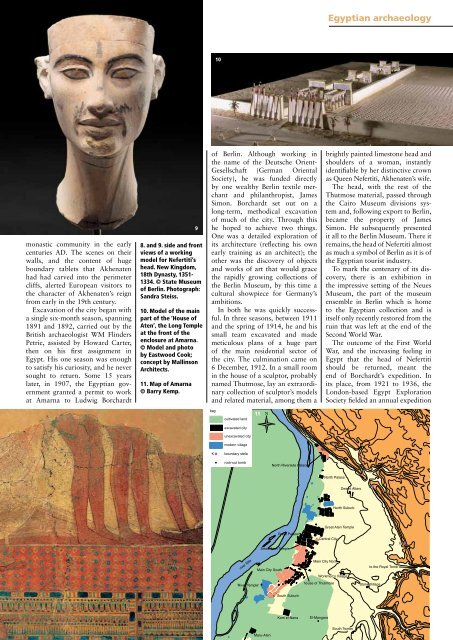Following Odysseus Not the end of the world Amarna city of light ...
Following Odysseus Not the end of the world Amarna city of light ...
Following Odysseus Not the end of the world Amarna city of light ...
- No tags were found...
You also want an ePaper? Increase the reach of your titles
YUMPU automatically turns print PDFs into web optimized ePapers that Google loves.
Egyptian archaeology10monastic community in <strong>the</strong> earlycenturies AD. The scenes on <strong>the</strong>irwalls, and <strong>the</strong> content <strong>of</strong> hugeboundary tablets that Akhenatenhad had carved into <strong>the</strong> perimetercliffs, alerted European visitors to<strong>the</strong> character <strong>of</strong> Akhenaten’s reignfrom early in <strong>the</strong> 19th century.Excavation <strong>of</strong> <strong>the</strong> <strong>city</strong> began witha single six-month season, spanning1891 and 1892, carried out by <strong>the</strong>British archaeologist WM FlindersPetrie, assisted by Howard Carter,<strong>the</strong>n on his first assignment inEgypt. His one season was enoughto satisfy his curiosity, and he neversought to return. Some 15 yearslater, in 1907, <strong>the</strong> Egyptian governmentgranted a permit to workat <strong>Amarna</strong> to Ludwig Borchardt8. and 9. side and frontviews <strong>of</strong> a workingmodel for Nefertiti’shead. New Kingdom,18th Dynasty, 1351-1334. © State Museum<strong>of</strong> Berlin. Photograph:Sandra Steiss.10. Model <strong>of</strong> <strong>the</strong> mainpart <strong>of</strong> <strong>the</strong> ‘House <strong>of</strong>Aten’, <strong>the</strong> Long Templeat <strong>the</strong> front <strong>of</strong> <strong>the</strong>enclosure at <strong>Amarna</strong>.© Model and photoby Eastwood Cook;concept by MallinsonArchitects.11. Map <strong>of</strong> <strong>Amarna</strong>© Barry Kemp.9<strong>of</strong> Berlin. Although working in<strong>the</strong> name <strong>of</strong> <strong>the</strong> Deutsche Orient-Gesellschaft (German OrientalSociety), he was funded directlyby one wealthy Berlin textile merchantand philanthropist, JamesSimon. Borchardt set out on along-term, methodical excavation<strong>of</strong> much <strong>of</strong> <strong>the</strong> <strong>city</strong>. Through thishe hoped to achieve two things.One was a detailed exploration <strong>of</strong>its architecture (reflecting his ownearly training as an architect); <strong>the</strong>o<strong>the</strong>r was <strong>the</strong> discovery <strong>of</strong> objectsand works <strong>of</strong> art that would grace<strong>the</strong> rapidly growing collections <strong>of</strong><strong>the</strong> Berlin Museum, by this time acultural showpiece for Germany’sambitions.In both he was quickly successful.In three seasons, between 1911and <strong>the</strong> spring <strong>of</strong> 1914, he and hissmall team excavated and mademeticulous plans <strong>of</strong> a huge part<strong>of</strong> <strong>the</strong> main residential sector <strong>of</strong><strong>the</strong> <strong>city</strong>. The culmination came on6 December, 1912. In a small roomin <strong>the</strong> house <strong>of</strong> a sculptor, probablynamed Thutmose, lay an extraordinarycollection <strong>of</strong> sculptor’s modelsand related material, among <strong>the</strong>m abrightly painted limestone head andshoulders <strong>of</strong> a woman, instantlyidentifiable by her distinctive crownas Queen Nefertiti, Akhenaten’s wife.The head, with <strong>the</strong> rest <strong>of</strong> <strong>the</strong>Thutmose material, passed through<strong>the</strong> Cairo Museum divisions systemand, following export to Berlin,became <strong>the</strong> property <strong>of</strong> JamesSimon. He subsequently presentedit all to <strong>the</strong> Berlin Museum. There itremains, <strong>the</strong> head <strong>of</strong> Nefertiti almostas much a symbol <strong>of</strong> Berlin as it is <strong>of</strong><strong>the</strong> Egyptian tourist industry.To mark <strong>the</strong> centenary <strong>of</strong> its discovery,<strong>the</strong>re is an exhibition in<strong>the</strong> impressive setting <strong>of</strong> <strong>the</strong> NeuesMuseum, <strong>the</strong> part <strong>of</strong> <strong>the</strong> museumensemble in Berlin which is hometo <strong>the</strong> Egyptian collection and isitself only recently restored from <strong>the</strong>ruin that was left at <strong>the</strong> <strong>end</strong> <strong>of</strong> <strong>the</strong>Second World War.The outcome <strong>of</strong> <strong>the</strong> First WorldWar, and <strong>the</strong> increasing feeling inEgypt that <strong>the</strong> head <strong>of</strong> Nefertitishould be returned, meant <strong>the</strong><strong>end</strong> <strong>of</strong> Borchardt’s expedition. Inits place, from 1921 to 1936, <strong>the</strong>London-based Egypt ExplorationSociety fielded an annual expeditionkeycultivated landexcavated <strong>city</strong>unexcavated <strong>city</strong>11NKmodern villageboundary stelaquarriesNorth Cityrock-cut tombNorth Riverside PalaceNorth PalaceDesert AltarsVNorth TombsNorth SuburbGreat Aten TempleGreat PalaceSmall Aten TempleCentral CityUriver Nile'River Temple'Main City SouthMain City NorthWorkmen's Villagehouse <strong>of</strong> Thutmoseto <strong>the</strong> Royal TombStone VillageSouth SuburbKom el-NanaEl-MangaraMaru-AtenSouth Tombs
















